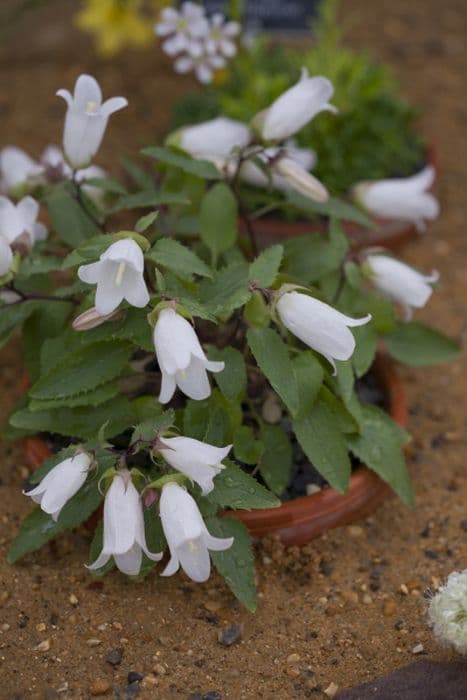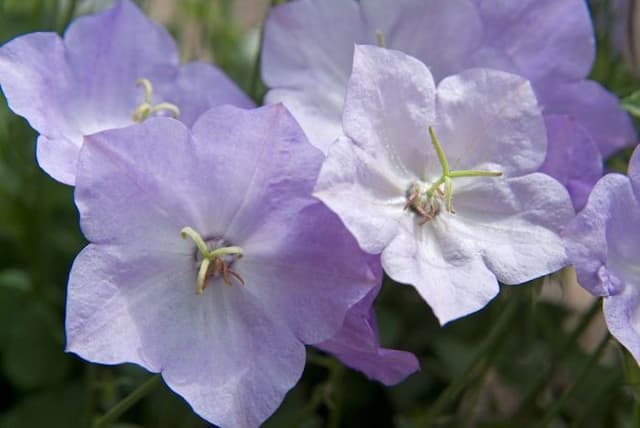Lobelia Lobelia erinus Waterfall Blue = 'Balobwablu' (PBR) (Waterfall Series)
![trailing lobelia [Waterfall Blue]](/_next/image?url=https%3A%2F%2Fplants-admin.emdemapps.com%2Fimages%2Fplants%2F%2Fimages%2F604b6470b1eb2.png&w=3840&q=75)
ABOUT
Lobelia erinus Waterfall Blue, commonly known as trailing lobelia, is an eye-catching plant that features an abundance of vibrant blue flowers. These blooms typically have a small white or lighter blue eye at the center, which adds contrast and depth to the overall floral display. The petals are delicate with a soft, velvety texture and are shaped like tiny trumpets. The foliage is equally attractive, consisting of dense, narrow leaves that form a lush backdrop to the profusion of flowers. The leaves are typically a rich green color, which complement the blue hues beautifully. This trailing lobelia's growth habit creates a cascading effect, making it a popular choice for hanging baskets, window boxes, or as a spiller plant in container combinations, where it can gracefully spill over the edges.
About this plant
 Names
NamesSynonyms
Edging Lobelia, Garden Lobelia, Trailing Lobelia, Cascade Lobelia.
Common names
Lobelia erinus 'Balobwablu'.
 Toxicity
ToxicityTo humans
Lobelia, which includes Lobelia erinus Waterfall Blue, contains several alkaloids, such as lobeline, which can be toxic if ingested in significant quantities. In humans, symptoms of lobelia poisoning can include nausea, vomiting, diarrhea, cough, dizziness, tremors, and more severe reactions could potentially lead to convulsions and coma. If any part of this plant is consumed by a person, it is important to seek medical attention.
To pets
Like humans, pets can also be affected by the toxicity of Lobelia if they ingest the plant. Symptoms of lobelia poisoning in pets may include vomiting, diarrhea, excessive drooling, lethargy, and possibly more serious neurological symptoms such as tremors or seizures. If you suspect your pet has ingested Lobelia, it is important to contact a veterinarian as soon as possible.
 Characteristics
CharacteristicsLife cycle
Annuals
Foliage type
Evergreen
Color of leaves
Green
Flower color
Blue
Height
4-6 inches (10-15 cm)
Spread
6-8 inches (15-20 cm)
Plant type
Herb
Hardiness zones
10
Native area
South Africa
Benefits
 General Benefits
General Benefits- Attractive Flowers: Produces an abundance of vivid blue flowers which can enhance the visual appeal of any garden or container.
- Extended Blooming Season: Offers a long flowering period from spring to fall.
- Easy to Grow: Known for its low maintenance, it's suitable for gardeners of all skill levels.
- Drought Tolerant: Once established, it can tolerate periods of drought, making it a good choice for water-wise gardens.
- Compact Size: Its compact growth habit makes it an excellent choice for borders, containers, and small spaces.
- Attracts Pollinators: Draws in beneficial insects like butterflies and bees, contributing to the health of the ecosystem.
- Versatile Use: Can be used in various garden settings including as edging plants, in rockeries, hanging baskets, and window boxes.
 Medical Properties
Medical PropertiesThis plant is not used for medical purposes.
 Air-purifying Qualities
Air-purifying QualitiesThis plant is not specifically known for air purifying qualities.
 Other Uses
Other Uses- Artistic Inspiration: Lobelia flowers are often used by artists and photographers for their brilliant blue color and delicate structure, inspiring creative works such as paintings and photographic series.
- Floral Arrangements: The bright blue flowers of Lobelia can be used to add a pop of color and texture to floral arrangements and bouquets.
- Garden Borders: Lobelia can be planted along the edges of garden paths or flower beds to create a visually appealing border with its cascading blooms.
- Companion Planting: Gardeners may use Lobelia as a companion plant to deter certain pests naturally when grown next to vegetables in a kitchen garden.
- Fairy Gardens: With its compact size and cascading blossoms, Lobelia is perfect for creating whimsical fairy gardens or miniature landscapes in small containers.
- Wearable Florals: Small blooms of Lobelia can be incorporated into wearable floral designs, such as flower crowns or boutonnieres, for special occasions.
- Educational Tool: Lobelia can be used in schools or educational programs to teach children about plant growth, pollination, and the importance of biodiversity.
- Seasonal Decor: Lobelia's flowers can be used as part of seasonal decor, especially in spring and summer-themed displays.
- Culinary Garnish: Although not commonly consumed, the vibrant Lobelia flowers can be used as an ornamental garnish to brighten up plates in gourmet culinary presentations.
- Photography Projects: The striking blue of Lobelia flowers makes them a favorite subject for macro photography projects and botanical studies.
Interesting Facts
 Feng Shui
Feng ShuiThe Lobelia is not used in Feng Shui practice.
 Zodiac Sign Compitability
Zodiac Sign CompitabilityThe Lobelia is not used in astrology practice.
 Plant Symbolism
Plant Symbolism- Devotion: Often in the language of flowers, lobelia represents devotion due to its perennial nature, reflecting an enduring or persistent affection.
- Distinction: The striking blue blooms can symbolize a uniqueness or standing out from the crowd. Lobelia's vivid color is often associated with a distinctive quality.
- Good Fortune: In some cultures, the blue of lobelia is thought to bring good luck and positive energy to a space, making it a plant that might be gifted with the symbolic meaning of best wishes.
 Water
WaterThe Lobelia, also known as Edging Lobelia or Trailing Lobelia, prefers consistent moisture, so water it thoroughly when the top inch of soil feels dry to the touch. Typically, this means watering once every week, but this can vary depending on climate and weather conditions. It's crucial to avoid waterlogging by ensuring good drainage. During hot spells or in particularly dry climates, you may need to water more frequently, potentially every few days. Aim to use about one gallon of water per plant, ensuring a deep watering that reaches the root zone.
 Light
LightEdging Lobelia thrives in locations with full sun to partial shade. For optimal growth and flowering, place it in a spot where it will receive morning sunlight and some afternoon shade, especially in hotter climates. These light conditions will help maintain vibrant colors and healthy foliage without the risk of scorching the delicate leaves.
 Temperature
TemperatureEdging Lobelia prefers moderate temperatures and will grow best when daytime temperatures range between 70°F and 80°F. It can survive minimum temperatures as low as 40°F, but frost can severely damage or kill the plant. To ensure robust growth, protect the plant from extreme heat and cold by situating it in a location that offers some temperature stability.
 Pruning
PruningPruning Edging Lobelia is essential to encourage bushier growth and continuous blooming. Deadhead spent flowers regularly and cut back the plant by one-third in midsummer if it becomes leggy or sparse. This will rejuvenate the plant and lead to a fresh flush of growth and flowers. The best time for pruning is after the first wave of flowering subsides.
 Cleaning
CleaningAs needed
 Soil
SoilThe best soil mix for the trailing lobelia (Lobelia erinus 'Waterfall Blue') is light, well-draining soil with a mix of peat, perlite, and compost. An ideal pH level should be slightly acidic to neutral, ranging between 6.0 and 7.0.
 Repotting
RepottingTrailing lobelia generally does not require frequent repotting and can be repotted every 1-2 years to refresh the soil, or when it outgrows its current pot.
 Humidity & Misting
Humidity & MistingTrailing lobelia prefers moderate humidity levels, and can tolerate the average humidity found in most homes without the need for additional measures.
 Suitable locations
Suitable locationsIndoor
Place in bright, indirect light, and keep soil consistently moist.
Outdoor
Full sun to partial shade, and ensure well-draining soil.
Hardiness zone
10-11 USDA
 Life cycle
Life cycleLobelia 'Waterfall Blue' begins its life cycle as a seed, typically germinating in warm, moist conditions during spring or within a controlled environment for early starts. After germination, the seedlings develop into juvenile plants with a rosette of basic green foliage, focusing on root and foliage development before flowering. As the plant matures, it begins to produce distinctive cascading stems adorned with intense blue flowers, which is a key characteristic of the Waterfall Series, attracting pollinators and aiding in the plant´s reproductive cycle. The blooming phase can occur from late spring to early fall, depending on the climate and growing conditions. Following pollination, the plant sets seed, which can be dispersed by wind or, more commonly, collected for future propagation. Eventually, as temperatures drop towards the end of the growing season, Lobelia 'Waterfall Blue' will enter a dormant phase or die back, particularly if it is grown as an annual in regions with cold winters.
 Propogation
PropogationPropogation time
Spring to Summer
Propogation: The most popular method of propagation for Lobelia erinus, commonly known as Eden Lobelia, is through seed sowing. Seeds should be sown in late winter to early spring, typically indoors to protect them from frosts. The seeds are very tiny, so it is advisable to simply sprinkle them on top of a well-draining seed starting mix, as they require light to germinate. After sowing, gently mist the surface to moisten it without covering the seeds with soil. The ideal temperature for germination is around 72 degrees Fahrenheit (22 degrees Celsius). Seedlings usually emerge within 14-21 days, after which they can be transplanted once the risk of frost has passed and they have developed a few true leaves. It's important that they are carefully handled during transplantation due to their delicate nature.









